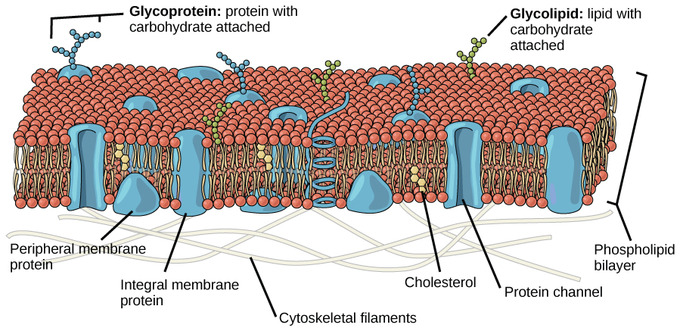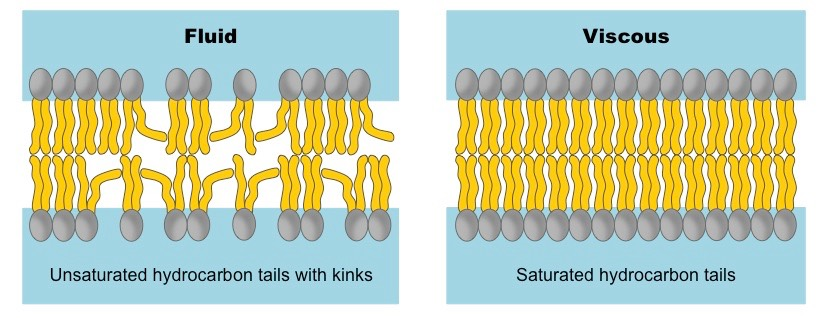

Do you wonder how molecules are transported inside cells?
The transport of molecules across the cell membrane or in the cell follows two pathways: passive transport and active transport. Active transport is the transport of molecules against a concentration gradient across the cell membrane using transport proteins and energy. In contrast, passive transport is a direct transfer of molecules across the membrane down the concentration gradient.
The transport rate of molecules down the concentration gradient depends on the permeability and fluidity of the cell membrane. These two properties, membrane permeability, and fluidity further depend on the physiological and structural characteristics of the cell membrane.
This article covers cell membrane permeability, methods to measure the rate of permeation of molecules, and the factors that affect the permeability of the cell. You will also get a glimpse of membrane fluidity and the factors that influence this property.
Permeability of a membrane is the rate of passive diffusion of molecules across the membrane. It’s the ease with which molecules pass through the membrane barrier.[1]
The cell membrane is selectively permeable and only allows specific molecules to enter the cell.[1] This function is essential for the normal functioning of organisms.
Fluidity is defined as the ability or ease of molecules to move in the membrane. It refers to the viscosity of the cell membrane and affects the diffusion of proteins and other molecules inside cells, thus, affecting their function.[2] This property is affected by phospholipid structure, cholesterol composition in the membrane, and temperature.[2]
The selective permeability and cell fluidity of the membrane are due to its structural composition. The cell membrane, also known as the plasma membrane or biological membrane, separates the interior from the outer surroundings.
It acts as a structural control barrier in transporting molecules inside the cells for metabolic regulations or other functions of the body. The membrane consists of lipids, protein, carbohydrates, and cholesterol.
The three classes of lipids that compose the membrane’s structure are phospholipids, glycolipids, and sterols. A phospholipid is composed of alcohol (glycerol and sphingosine), fatty acids, phosphate, and alcohol, attached to phosphates.
The two main classes of phospholipids include glycerophospholipids and sphingophospholipids. Other than these two, glycolipids and sterols also have significant contributions to building the membrane structure.
Glycolipids are carbohydrates covalently attached to lipids, while sterols are multi-hydroxy alcohols with multiple ring structures. The principal sterol present in the biological membrane is cholesterol.
It’s an integral part of the cell membrane. The two types of proteins involved in the structural formation of membranes are intrinsic membrane protein and extrinsic membrane protein.
Intrinsic membrane proteins are either completely or partially embedded in the lipid bilayer of the membrane. In contrast, extrinsic membrane proteins are loosely bound proteins attached to the surface of the membrane.
They are present on the surface of the membrane. They are either glycoproteins (carbohydrates attached to proteins) or glycolipids (carbohydrates attached to lipids).
Carbohydrates on the surface of plasma membranes consist of 2 to 60 monosaccharide units that can be straight or branched. They coat the cell surface and protect it from any damage or harm and mediate cell-cell adhesion events.

Figure: An illustrative diagram of cell membrane showing its different structural elements.[3]
The two main players in the cell membrane that affects its permeability are:
The saturated fatty acid tightly packs the protein bilayer, making it difficult for the molecules to pass across the membrane. And, the bulky hydrophilic parts of the hydrophilic groups of phospholipids trap the polar and charged molecules, restricting their movement through passive diffusion.

Figure: An illustration of the effect of saturated and unsaturated carbons on membrane fluidity.[5]
An increase in the temperature increases membrane permeability. At a freezing 0 degrees temperature, the phospholipids in the membrane are tightly packed and become rigid, and this decreases the permeability.[6] However, increasing the temperature up to 45 degrees celsius increases the permeability because of the loosening of the phospholipid structures in the membrane.[6]
The normal pH of the cell is 7. Increasing or decreasing the pH of a cell surrounding by 1 unit, that is, to 6 and 8, disrupts the structural forms of the membrane, reduces the permeability of the membrane, and disrupts its function.[3]
Smaller molecules without any charges, such as CO2, N2, O2, and molecules with high solubility in fat such as ethanol, have the fastest rate of diffusion.[7] These molecules can easily move across the membrane through passive diffusion without any membrane protein or energy.
The permeability decreases for molecules having charges or those bigger in size.[7] These structural features of molecules don’t have any effect on membrane fluidity.

Figure: A representation of permeability of molecules across the membrane, based on their size and charges.[7]
The permeability of the cell membrane plays an essential role in the transport of molecules. Scientists are working to alter the membrane’s permeability for its application in enhancing and smoothing the process of drug delivery in cells at the target location.
That’s why scientists have designed certain approaches to enhance membrane permeation and achieve drug delivery, some of which are explained below:[8]
Membrane permeation is an essential factor considered while designing principles that maximize obtaining a drug and its distribution in the organisms. Better permeability increases the bioavailability (concentration of a chemical that is available for biological action) of the drug molecule.[8]
In such efforts, conjugating compounds to known transporter substrates are designed to have improved permeation, releasing the drug molecule in the membrane.[8]
Peptides can not cross the membrane passively, and that’s why scientists are trying to alter their physical properties like conformational flexibility and polarity to improve their permeability across the membrane.[8]
For example, scientists proposed that cyclizing a given peptide and methylating nitrogen involved in the amide bond can improve the permeation of the peptide.[8]
Furthermore, in some cases, cyclization by changing the peptide’s α-helical content and the presence of arginine residue within α-helices is also found to have increased permeability.[8]
The size and polarity of protein molecules make it difficult for them to cross the membrane passively.[8] Due to the vast differences between different proteins’ physicochemical properties, there’s no generalized technique to enhance their permeability. Given below are some approaches introduced by scientists to ease the delivery of proteins across the membrane:[8]
Cell permeability and cell fluidity are two essential properties, having roles in transporting molecules across the membrane. These properties are affected by physiological factors like temperature, pH, and the membrane’s composition. Any extremity of these factors disrupts the membrane molecules that build the membrane, thus, affecting the normal functioning of the organism.
The permeability of molecules is a trending research topic among scientists because of its role in drug delivery. They are working to alter the properties of the membrane or create certain approaches that can enhance drug delivery in cells and treat certain diseases.
Some of the methods that have been or are being tested include mechanical disruption of the membrane, virus-based strategies, protein-based strategies, and lipid and polymer-based strategies.
These approaches are still not frequent in practice and need serious consideration and in-depth analysis before bringing them in for actual medical practices. But they do show promising potential in the medical field.
